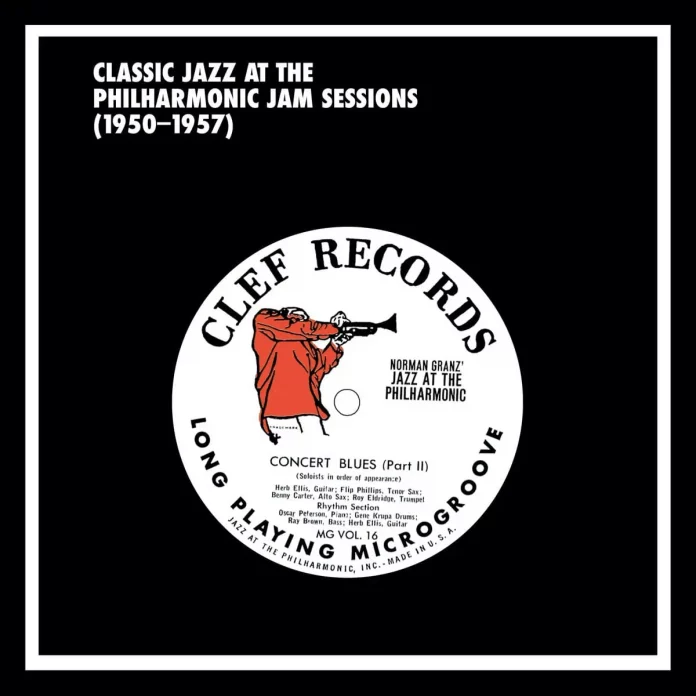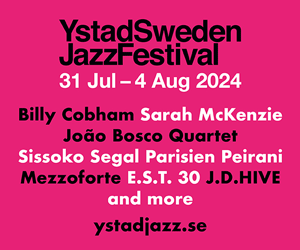For 80 years, without remorse or relenting, JATP has been charged as the blackguard of jazz and anyone who admits enjoying its concerts has been classed as an automatic clown.
Guilty as charged, I’ve relished the series since I bought the Melodisc 1944 JATP 78s with Nat Cole and Les Paul playing the best jazz that they ever put onto disc. Recently out of short pants, I indulged myself with the concurrent eagle screaming of Illinois Jacquet and his fellow reed users.
Even Granz himself had little idea of what he wanted when he started the crude billings in the early 40s that eventually matured into one of the most robust jazz institutions, JATP. Norman could foretell the impending financial hammering, and come it did. When the early tour collapsed, Granz, selling his personal possessions to raise the money, paid the musicians’ first-class train fares to wherever they wanted to go and this event established his reputation for life as an honest producer.
The manner in which Norman Granz treated his musicians meant that the best flocked to him. Normally they avoided crowd-pleasing as much as possible, but Flip Phillips, for example, deliberately abused his tenor to send the rabble on a nightly rampage. Illinois Jacquet had suffered from musical rabies long before he joined and he became the prime offender of screech. The reputations of both remain blotted to this day.
Sadly these imperfections set many listeners against JATP, and that is a shame, for the collective title embraced far more great jazz than it did saxophone indigestion.
This 10-CD set is a fine example and has a multitude of great performances from Parker, Getz and Hawkins (none of whom compromised their styles in any way) and by some more of the finest players of the day. Amongst the memorable satisfactions are solos from Hank Jones, Peterson, Gillespie, Ella, J J Johnson, Lester Young, Bill Harris, Shavers, Willie Smith, Barney Kessel, Herb Ellis – I could go on. The rhythm sections are all outstanding with Ray Brown a dependable giant. This was the period when Norman and his musicians invented the ballad medley and medleys with exquisite performances are present from the first session onwards. A good example of high quality, on the first two discs, is the piano work of Hank Jones, more fulsome than his usual, but distinguished with his typical good taste. It’s odd also that Peterson’s early stuff here sounds uncluttered compared with his later work.
Harry Edison is in his element – appreciated the more because most of his and Hank’s JATP work here never saw daylight in this country until now. Edison, swiftly to be succeeded by Eldridge, Shavers and Gillespie, might have been designed for the role and it’s a pity he’s only on the first session, which, incidentally, is the best in the box. Dating from 1950, it is made so because, on Ghost Of A Chance, it includes enchanted solos by Lester Young and Bill Harris, in my experience among the best each of them ever played and the whole set is a classic of jazz.
This box includes the second generation of Granz’s tours when the Roman orgy level had subsided a little. When Getz and Hawkins arrived around 1957 they were generally able to lift the tone a little by retaining their own styles unblemished. Slim Gaillard and Granz went into a phone booth in Los Angeles and, with a large pile of coins provided by Norman, phoned Hawk in New York. Norman told Hawk that he’d be pleased to put on a JATP concert featuring Hawk. Ever direct, Hawk asked “What’s it pay?” He asked for $100.
Norman normally paid his musicians $20 or $25. But Hawk had been a major favourite since Norman was a boy. “I’ll pay it,” he said. Hawk had been on the East Coast for most of his life, and Norman had no idea how the tenorist’s style might have changed over the years. “I’ll do it,” he said, and Hawk got his hundred bucks. Delighted with Hawk’s “modernism”, he added Billie, Willie Smith, Charlie Ventura, Wardell Gray and Illinois Jacquet to the cast.
At one concert Norman used together the five tenors of Young, Getz, Hawkins, Jacquet and Phillips with Stitt thrown in on alto, presumably just to show he could do it. Lady Be Good features the infallible Miss Fitzgerald with the six saxes restricted to riffing behind her.
Ella had been established as being beyond category soon after her arrival on the scene in 1935. Granz regarded her as his holy grail and she never let him down. In a simplified assessment (pace Billie Holiday) Ella was probably the best jazz vocalist ever. But this is an instrumental album, and she contributes only four dazzling and acrobatic vocals.
Hawk’s earliest appearances aren’t included here but you may feel that his improvising outclasses everyone else in this box. He remained a true giant of jazz and his sessions here on CDs 1, 9 and 10 are jazz gold – his numbers are with Roy Eldridge and John Lewis or Hank Jones. Willie Smith and Benny Carter are inspired and immaculate. I was delighted to see that trombonist Bill Harris is on half a dozen of the sessions, and he has a long and explosive solo on the 1952 Jam Session Blues. Probably due to crowding of the horn players on stage, the ever-polite Harris is often slightly off mike.
Never mind the show-boating and ignore JATP’s ill-repute. These 10 CDs include concerts of a very high standard and even the pain-in-the-ass drum solos are held to a minimum. I was delighted with the general high quality of the recorded sound, although there are times when a soloist might be off-mike – not sufficiently to mar one’s pleasure, though. The booklet is in a new style using robust pages and housing a brilliant and huge essay by John McDonough which took me the best part of two days to absorb!
Discography
CD1: (1) Norgran Blues; Lady Be Good; Ghost Of A Chance; Indiana; (2) Yesterdays; Hawk’s Tune; Stuffy; (3) Air Mail Special; (4) Jam Session Blues (78.36)
CD2: (4) The Trumpet Battle; Ballad Medley; Cottontail; (5) Idaho; Sophisticated Lady; Flying Home; Drum Boogie; (6) The Drum Battle; (7) Perdido ( 64.13)
CD3: (8) Concert Blues; (9) Cool Blues; Ballad Medley; Cottontail (79.56)
CD4: (10) The Drum Solo; (11) Lester’s Blues; I Cover The Waterfront; Lester Leaps In; (12) One O’Clock Jump; (13) Indiana; Somebody Loves Me; Laura; Stompin’ At The Savoy; (14) Flying Home; (15) Jazz Concert Blues (70.41)
CD5: (15) The Challenges; Ballad Medley; Drum Solo; (16) It’s Only A Paper Moon; Easy Living; I’ll Remember April; Autumn Leaves; Now’s The Time; Air Mail Special; (17) How High The Moon; Body And Soul (73.20)
CD6: (17) Flying Home; (18) The Blues; (19) The Modern Set; (20) The Swing Set; (21) Ballad Medley; Buddy Rich’s Explosion (66.25)
CD7: (22) Honeysuckle Rose; Ballad Medley; Jumpin’ At The Woodside; Drum Solo; (23) Slow Blues; Merry-Go-Round (60.21)
CD8: (23) Ballad Medley; Drum Solo; (24) Bean Stalkin’; The Nearness Of You; Time On My Hands; The Walker; Tea For Two; Blue Moon; Cocktails For Two; Kerry; (25) Billie’s Bounce; My Funny Valentine; Crazy Rhythm (76.23)
CD9: (25) It Never Entered My Mind; Blues In The Closet; (26) Stuffy; (27) Stompin’ At The Savoy; (28) Slow Blues; Merry-Go-Round Ballad Medley; Drum Solo; (29) Bean Stalkin’; I Can’t Get Started (75.53)
CD10: (29) Time On My Hands; The Walker; (30) Billie’s Bounce; My Funny Valentine; Crazy Rhythm; Yesterdays; It Never Entered My Mind; Blues In The Closet; (31) Stuffy; (32) Stompin’ At The Savoy; Lady Be Good (73.53)
(1) Harry Edison (t); Bill Harris (tb); Flip Phillips, Lester Young (ts); Hank Jones (p); Ray Brown (b); Buddy Rich (d). Carnegie Hall, NYC, 16 September 1950.
(2) Coleman Hawkins (ts); Hank Jones (p); Ray Brown (b); Buddy Rich (d). Same concert as (1).
(3) The Buddy Rich Trio: Hank Jones (p); Brown (b); Rich (d). Same concert as (1).
(4) Roy Eldridge; Charlie Shavers (t); Benny Carter (as); Flip Phillips; Lester Young (ts); Oscar Peterson (p); Barney Kessel (elg); Brown (b); Rich (d). Carnegie Hall, NYC, 13 September 1952.
(5) The Gene Krupa Trio: Willie Smith (as); Jones (p); Gene Krupa (d). Same concert as (4).
(6) The Drum Battle: Gene Krupa, Rich (d). Same concert as (4).
(7) Eldridge, Shavers (t); Carter (as); Phillips, Young (ts); Peterson (p); Kessel (elg); Brown (b); Rich, Krupa (d); Ella Fitzgerald (v). Same concert as (4).
(8) Eldridge, Shavers (t); Harris (tb); Carter, Smith (as); Phillips, Ben Webster (ts); Peterson (p, org); Herb Ellis (elg); Brown (b); Krupa (d). Bushnell Memorial Auditorium, Hartford, probably 11 September 1953.
(9) Eldridge, Shavers (t); Harris (tb); Carter, Smith (as); Phillips, Webster (ts); Peterson (p); Ellis (elg); Brown (b); J. C. Heard (d). Carnegie Hall, NYC, 19 September 1953.
(10) Eldridge, Shavers (t); Harris (tb); Phillips, Webster (ts); Peterson (p); Ellis (elg); Brown (b); Heard (d). Same concert as (9).
(11) Lester Young Quintet: Young (ts); Peterson (p); Ellis (g); Brown (b); Heard (d). Same concert as (9).
(12) Eldridge, Shavers (t); Harris (tb); Carter, Smith (as); Phillips, Webster, Young (ts); Peterson (p); Ellis (elg); Brown (b); Heard (d). Same concert as (9).
(13) Gene Krupa Trio: Carter (as); Peterson (p); Krupa (d). Same concert as (9).
(14) Eldridge, Shavers (t); Harris (tb); Carter, Smith (as); Phillips, Webster, Young (ts); Peterson (p); Ellis (elg); Brown (b); Krupa, Heard (d). Same concert as (9).
(15) Eldridge, Dizzy Gillespie (t); Harris (tb); Phillips, Webster (ts); Peterson (p); Ellis (elg); Brown (b); Louie Bellson (d). Bushnell Memorial Auditorium, Hartford, 1 September 1954.
(16) The JATP Quintet: Buddy DeFranco (cl); Peterson (p); Ellis (elg); Brown (b); Rich (d). Same concert as (14).
(17) The JATP Sextet: DeFranco (cl); Lionel Hampton (vib, d); Peterson (p); Ellis (elg); Brown (b); Rich (d). Same concert as (15).
(18) Eldridge, Gillespie (t); Illinois Jacquet, Phillips, Young (ts); Peterson (p); Ellis (elg); Brown (b); Rich (d).
Opera House, Chicago, 2 October 1955.
(19) Gillespie (t); Young (ts); Peterson (p); Ellis (elg); Brown (b); Rich (d). Same concert as (18).
(20) Eldridge (t); Jacquet, Phillips (ts); Peterson (p); Ellis (elg); Brown (b); Rich (d). Same concert as (18).
(21) Eldridge, Gillespie (t); Jacquet, Phillips, Young (ts); Peterson (p); Ellis (elg); Brown (b); Rich (d). Same concert as (18).
(22) Eldridge, Harry “Sweets” Edison (t); Phillips, Jacquet (ts); Peterson (p); Ellis (elg); Brown (b); Rich (d). Hollywood Bowl, LA, 15 August 1956.
(23) Sonny Stitt (as); Jacquet, Phillips, Young (ts); Peterson (p); Ellis (elg); Brown (b); Jo Jones (d). Civic Opera House, Chicago, 29 September 1957.
(24) Eldridge (t); Coleman Hawkins (ts); John Lewis (p); Percy Heath (b); Connie Kay (d). Same concert as (23).(25) Stan Getz (ts); J.J. Johnson (tb); Peterson (p); Ellis (elg); Brown (b); Kay (d). Same concert as (23).
(26) Eldridge (t); Johnson (tb); Getz, Hawkins (ts); Peterson (p); Brown (b); Kay (d). Same concert as (23).
(27) Eldridge (t); Johnson (tb); Stitt (as); Young, Jacquet, Hawkins, Getz, Phillips (ts); Peterson (p); Ellis (elg); Brown (b); Kay (d); Fitzgerald (v). Same concert as (23).
(28) Stitt (as); Jacquet, Phillips, Young (ts); Peterson (p); Ellis (g); Brown (b); Jones (d). Shrine Auditorium, LA, 9 October 1957.
(29 ) Eldridge (t); Hawkins (ts); John Lewis (p); Heath (b); Kay (d). Same concert as (28).
(30) Getz (ts); Johnson (tb); Peterson (p); Ellis (g); Heath (b); Kay (d). Same concert as (28).
(31) Eldridge (t); Johnson (tb); Getz, Hawkins (ts); Lewis (p); Heath (b); Jones (d). Same concert as (28).
(32) Eldridge (t); Johnson (tb); Stitt (as); Young, Jacquet, Hawkins, Getz, Phillips (ts); Peterson (p); Ellis (elg); Brown (b); Jones (d); Fitzgerald (v). Same concert as (28).
Mosaic MD10-275















